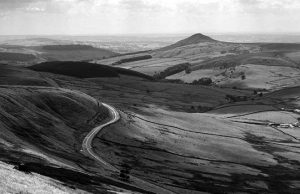THURSBITCH
A Novel by Alan Garner
I remember Alan Garner from the early 70s, when people were talking about his book The Weirdstone of Brisingamen, and I came across him again recently when his novel Thursbitch was mentioned in an article on “sentient landscape” – the idea that the world apart from ourselves may be somehow aware in ways which we don’t or can’t acknowledge. One aspect of the uncanny – the feeling that we are being observed – clearly has close links with this idea. What if the stones themselves are watching us?
Thursbitch is the name of a valley in the south Pennines not far from Macclesfield, and Garner’s novel, published in 2003 but long in the making, gives the location a powerfully threatening and magical character. There are standing stones which may or may not move in the night, strange geological formations and old stone houses, now abandoned and tumbling.
Two strands run through the narrative. An eighteenth century community still clings to ancient beliefs, which, along with associated practices, are being threatened by new Christian ideas and a new politics of land management. The central character is the journeyman John Turner, who appears to be only the most recent shaman of an ancient line, and he performs the strange rituals that keep the farming community safe.
In the present day, two friends, Sal and Ian, habitually visit the valley and walk the surrounding landscape. Time has a habit of shifting around here, and sometimes, through the mist or in a blizzard, John sees Sal and Ian, and sometimes Sal and Ian see or hear John. Artifacts from the earlier time appear in the later.
The novel is challenging. John Turner and his community speak in a thick Cheshire accent that is quite opaque at times. and the relationship between Sal and Ian is complicated. But the book lingers in the mind long after the reading has finished.
In 2008, Garner gave a lecture about the evolution of his story. In 1952, he had been running on the moors of the Southern Pennines, close to the valley of Thursbitch, and came across a memorial stone by the side of the road upon which was carved
HERE JOHN TURNER WAS CAST AWAY IN A HEAVY SNOWSTORM IN THE NIGHT ON OR ABOUT THE YEAR 1755
On the hidden reverse of the stone, he discovered more lettering:
THE PRINT OF A WOMAN’S SHOE WAS FOUND BY HIS SIDE IN THE SNOW WHERE HE LAY DEAD
The strangeness of such a find stayed with Garner, and eventually in 1972 “it was laid upon me that the story of John Turner must be told. But I’d no idea of what that story was or might be”. It was during his research to pin down that story that the uncanny flavour of the moorland landscape and its inhabitants began to emerge.
He discovered that the memorial stone had been erected by a Turner relative in the nineteenth century (and that the date should have been 1735, not 1755), and pieced together the details of John Turner’s life – he was born in 1706 and became a packman carrying salt from Chester to Derby, returning with malt. These details were still, in the 1970s, well know to the farmers of Saltersford (another valley close to Thursbitch) with whom Garner consulted over many years. The unexplained death of John Turner was still making them uneasy; he died in a snowstorm not half a mile from his home, and an experienced packman, very famliar with the ways and the weathers of his path, would have had the knowledge to protect himself and his beasts from such conditions.
Garner got something else from those farmers; “it was a sense that they were glad of my interest. They were, and still are, troubled in their souls by something they can’t describe and only begin to articulate.”
It wasn’t only the farmers who found the area unsettling. Garner met a GP whose practice, from 1948, had been in the hill country to the north east of Macclesfield. The doctor said he’d “never been happy with Saltersford, and always dreaded … a night call there”.
A church dedicated to St John the Baptist was built in 1732, close to a monolith at a site known as Jenkin Cross – but the Bishops of Chester refused to consecrate it for 61 years, and only then on condition that Jenkin Chapel, as it was known, be re-dedicated to St John the Evangelist. Garner points to the fact that St John the Baptist “frequently accumulated folkloric and mythic and pre-Christian baggage” and suggests that this was the reason for the Church’s reluctance.
The vicar responsible for Jenkin Chapel had, in 1972 at the start of his term, been told by the Church Wardens that “it would not be safe for ‘a man of the cloth’ to enter the valley. One of them had said that he himself never went there, because it ‘was not a healthy part’ “. The vicar respected this advice and “he also said that the people of Saltersford think of it as ‘no good place’, ‘not right’ …. ‘I wouldn’t like to go up myself. I think the valley needs feeding’.”
During his researches, Garner wanted permission to drive along the Western ridge of Thursbitch. The farmer’s response to the request is the most telling of all. He agreed but “he said he wanted me down by dusk and he wanted me to let him know I was down.
“You see.” Pause. “There isn’t a farmer in all these hill around.” Pause. “As will open his door after dark.” Pause. “Not even to cross the yard”. Pause. “Without he’s got his gun”. “Not that it would be of any use.” “But it makes you feel better.” “Somehow ……”
Read the full text of Garner’s lecture here.



